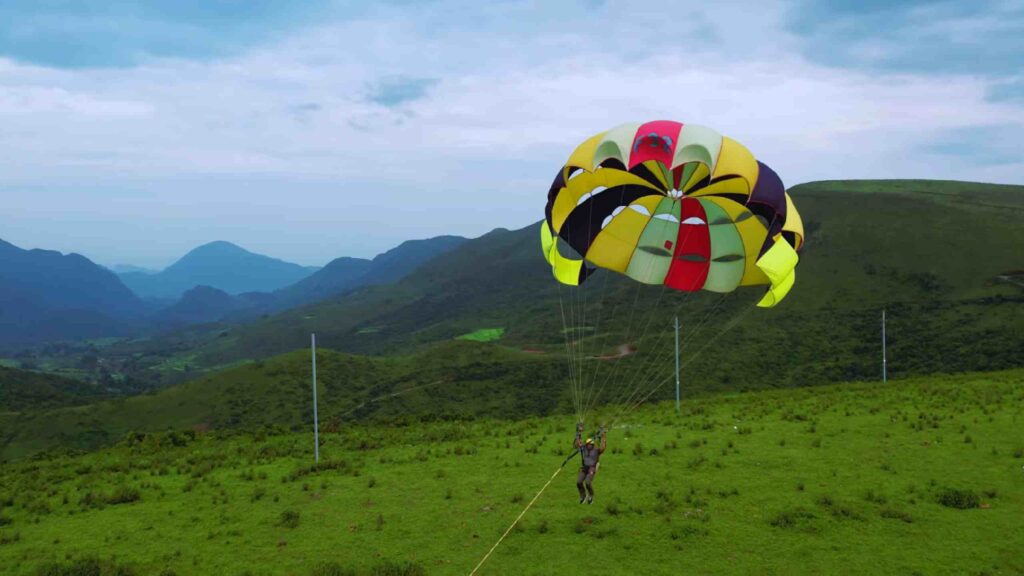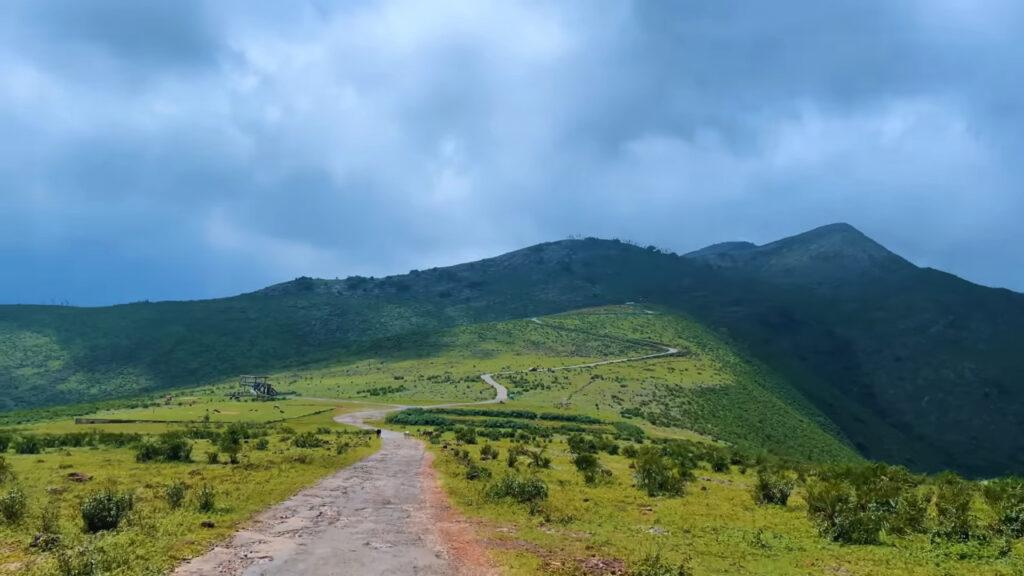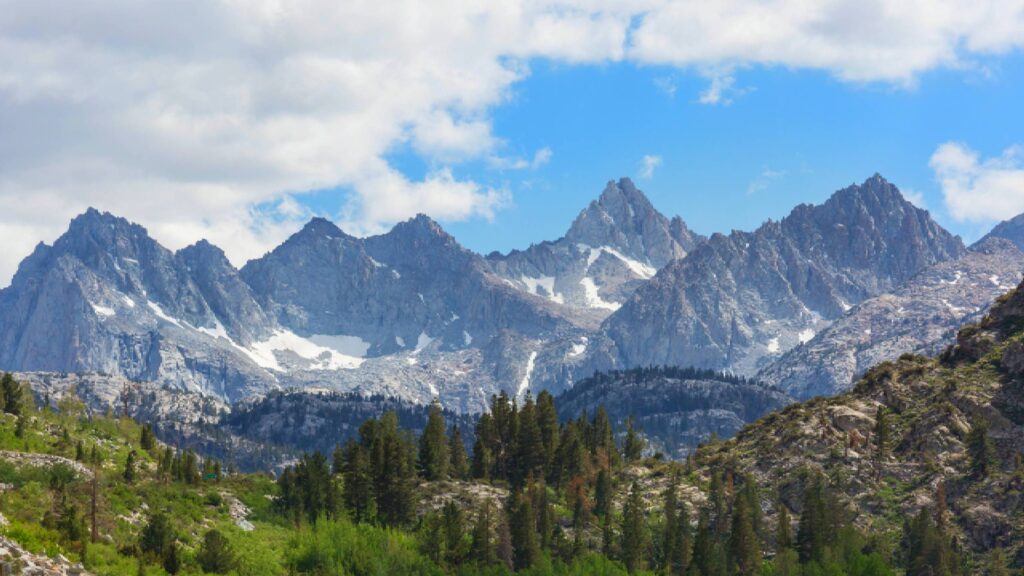Santorini is one of Greece’s most breathtaking destinations, known for its iconic whitewashed buildings, deep blue seas, and unforgettable sunsets. From ancient ruins and volcanic beaches to savoring local wines and wandering charming villages, Santorini offers a perfect blend of natural beauty, rich history, and cultural charm.
If planning a honeymoon, a solo escape, or a family vacation, this complete guide to the best things to do in Santorini will help you make the most of every magical moment on this iconic island.
Top Places to Visit in Santorini for First-Time Travelers
Those setting foot on this volcanic island for the first time, there’s no shortage of must-visit spots that define the Santorini experience.
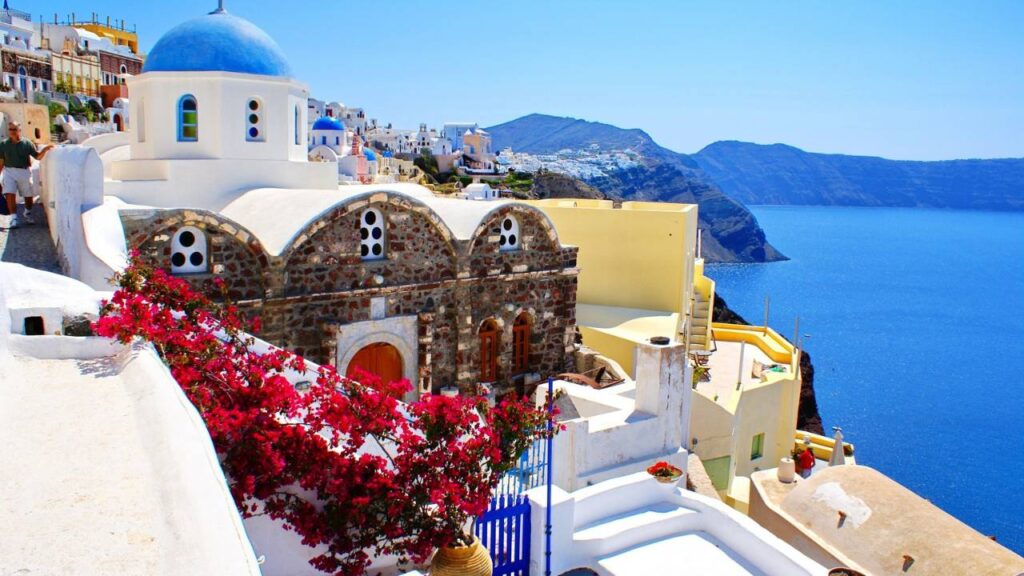
1. Oia Village
Oia is perhaps the most iconic village in Santorini, drawing visitors from all over the world to its picture-perfect streets and breathtaking views. The village is famous for its vibrant sunsets, where the sky turns into a palette of reds, oranges, and purples as the sun dips below the horizon, creating a magical scene that’s hard to match.
Visitors flock to the Oia Castle ruins to secure the best vantage point, but the beauty of the village extends beyond the sunsets. Strolling through Oia’s narrow, cobblestone alleys, you’ll encounter an array of art galleries showcasing local talent, boutique stores filled with unique souvenirs, and traditional tavernas serving delicious Greek cuisine. With its blend of serenity and charm, Oia embodies the essence of Santorini.
2. Fira (Thira)
Fira, the bustling capital of Santorini, offers a dynamic contrast to the more tranquil villages like Oia. Perched on the edge of the caldera, Fira boasts sweeping views of the Aegean Sea and the volcanic islands, making it an excellent spot for photos and admiring the landscape. The town’s narrow streets are lined with a variety of shops, from luxury boutiques to local markets, where you can find everything from high-end fashion to handmade jewelry.
To experience Santorini’s nightlife, Fira is the place to be, with a wide range of bars, clubs, and restaurants offering vibrant atmospheres. Aside from shopping and partying, Fira is home to cultural treasures, such as the Museum of Prehistoric Thira, which showcases fascinating Minoan artifacts and gives insight into the island’s ancient history.
3. Akrotiri Archaeological Site
Akrotiri Archaeological Site is a must-visit for history enthusiasts, as it offers a rare glimpse into one of the most advanced civilizations of the ancient world. Often referred to as the “Pompeii of the Aegean,” Akrotiri was a thriving Minoan settlement that was abruptly buried under volcanic ash during a catastrophic eruption around 3,600 years ago.
The site is remarkably well-preserved, with intact buildings, frescoes, and artifacts that reveal the sophistication of this early civilization. Visitors can walk through the ruins, exploring the remains of houses, streets, and even a multi-story building, all of which offer clues about the daily life of the people who once lived here. The discovery of this ancient city provides invaluable insight into the early history of Santorini and the Aegean world.
4. Red Beach
Red Beach, located near the Akrotiri Archaeological Site, is one of Santorini’s most visually striking beaches. As its name suggests, the beach is framed by towering red volcanic cliffs, which create a dramatic backdrop against the deep blue waters of the Aegean Sea. While it may not be the ideal spot for swimming due to the occasional falling rocks from the cliffs, Red Beach is still worth a visit for its unique beauty and the stunning photography opportunities it offers.
Contrast of the red sand with the turquoise sea creates an unforgettable scene, and many visitors enjoy relaxing on the beach, soaking in the surrounding natural beauty, or exploring the nearby coastal paths. Just be cautious, as the beach is known for occasional rock slides, so it’s best to take caution when venturing near the cliffs.
5. Pyrgos Village
To escape the tourist crowds and experience a more authentic side of Santorini, Pyrgos Village is an absolute gem. Located on the highest point of the island, Pyrgos offers panoramic views that stretch across the entire island, including the caldera and the neighboring islands. Unlike the more famous villages like Oia and Fira, Pyrgos retains a quieter, more laid-back atmosphere, making it a perfect spot for a leisurely stroll through its charming streets.
Village is rich in history, with its medieval castle and winding alleys that wind their way up to the top of the hill. Visitors can enjoy the remnants of ancient buildings, traditional Cycladic architecture, and enjoy the local vibe, which feels much more like the real Santorini. Pyrgos is also home to some excellent local tavernas where you can sample fresh Greek cuisine in a relaxed setting.
Hidden Place in Santorini You Shouldn’t Miss
While Santorini is world-famous for its main attractions, it also has lesser-known treasures that offer peace, authenticity, and unique experiences.
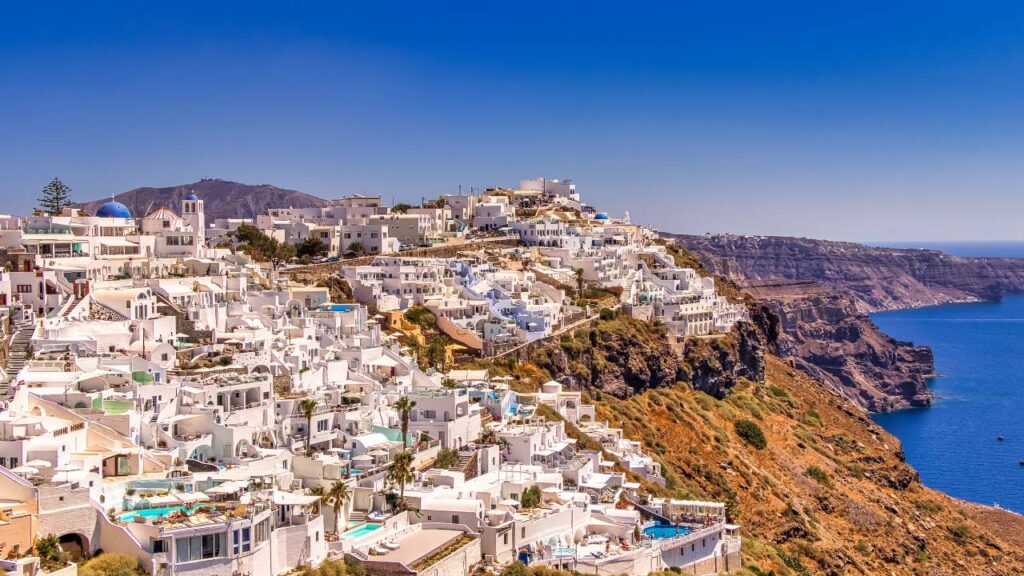
1. Emporio Village
Emporio Village offers a peaceful escape with its medieval charm, narrow stone paths, and ancient windmills. The village’s quiet streets, dotted with traditional homes and the remains of a fortified castle, provide a glimpse into Santorini’s past, making it perfect for a relaxed stroll away from the crowds.
2. Megalochori
Megalochori is a serene village filled with neoclassical mansions and winding streets. Known for its underground wine cellars, it offers a chance to visit Santorini’s winemaking traditions and experience local hospitality. Its peaceful atmosphere and traditional architecture make it a charming spot to unwind.
3. Vlychada Beach
Vlychada Beach stands out with its unique, moon-like rock formations and tranquil atmosphere. Less crowded than other beaches, it’s perfect for those seeking solitude and natural beauty. The beach’s serene environment, surrounded by white volcanic cliffs, offers a peaceful retreat for visitors.
4. Skaros Rock
Skaros Rock, near Imerovigli, offers stunning caldera views and a historical 13th-century castle. The moderate hike to the top rewards visitors with breathtaking panoramic views of the Aegean Sea, especially during the golden hour when the landscape is bathed in soft light.
5. Cave Houses & Traditional Homes:
Santorini’s traditional cave houses, carved into volcanic rock, provide a unique glimpse into the island’s architectural heritage. Many are still used as homes or can be rented, offering a one-of-a-kind stay that combines historical charm with modern comforts, perfect for those wanting an authentic experience.
Best Time to Visit Santorini for Weather, Views, and Deals
Timing is everything when planning your trip to Santorini. Each season offers a different experience, and knowing when to go can greatly enhance your journey.
Peak Season (June to August):
Santorini comes alive during the peak season with tourists flocking to the island for its vibrant energy, festivals, and hot weather. Expect high prices, crowded attractions, and lively nightlife. This is the best time for beach lovers and party-goers who want to experience the full buzz of the island.
Shoulder Season (April to June & September to October):
The shoulder season offers the perfect balance of pleasant weather, fewer crowds, and more affordable accommodations. With mild temperatures and beautiful views, these months are ideal for sightseeing, photography, and relaxed exploration. It’s a great time to enjoy Santorini without the hustle and bustle of the peak season.
Off-Season (November to March):
During the off-season, Santorini quiets down, and many tourist services close for the winter. Though the weather is cooler and less predictable, this time offers a peaceful and authentic experience. It’s the best period for quiet hikes, fewer tourists, and cheaper stays, allowing you to visit the local side of the island.
Santorini Itinerary: 3, 5, and 7-Day Travel Plans
Crafting your itinerary based on your trip length helps ensure you get the most out of Santorini. Here’s how to make the most of your time:
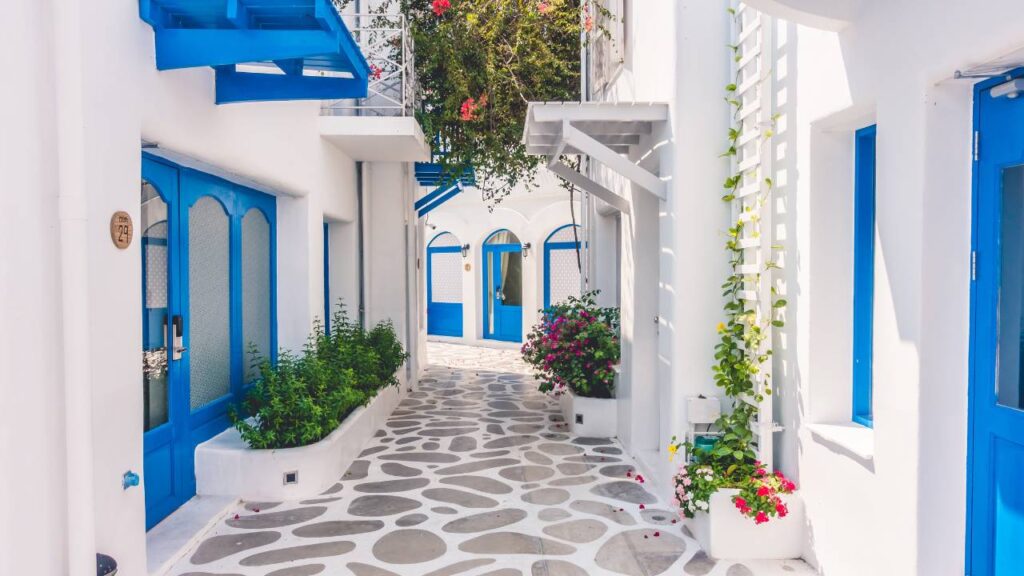
3-Day Itinerary: Quick Escape
Day 1: Visit Fira and Hike to Oia
Start by exploring Fira, the island’s lively capital with its shops, cafes, and stunning caldera views. Then, take a scenic 3-hour hike to Oia, passing through dramatic landscapes. In Oia, enjoy the iconic sunset and its charming streets.
Day 2: Visit Akrotiri, Red Beach, and Sunset in Oia
Visit the Akrotiri Archaeological Site, a preserved Minoan city. Then head to Red Beach for some sightseeing, before enjoying a sunset dinner in Oia, offering stunning views and great local food.
Day 3: Catamaran Cruise or Kamari Beach
Choose between a catamaran cruise around the caldera, stopping for swimming and volcanic hot springs, or a relaxing day at Kamari Beach with its black sand and vibrant atmosphere.
5-Day Itinerary: Balanced Experience
Day 4: Pyrgos, Megalochori, and Wine Tasting
Pyrgos for panoramic views and a peaceful atmosphere. Then visit Megalochori to enjoy its traditional streets and underground wine cellars. End with a wine tasting at Santo Wines with breathtaking caldera views.
Day 5: Volcano Tour and Thirassia Island
Take a boat trip to Nea Kameni volcano for a hike and swim in the volcanic hot springs. Then visit the peaceful Thirassia Island for a quiet meal and beautiful views.
7-Day Itinerary: Full Island Immersion
Day 6: Emporio and Perissa Beach
Visit the quiet village of Emporio with its medieval charm, and then head to Perissa Beach for a relaxed day by the sea, far from the crowds.
Day 7: Spa Day or visit Fira’s Art
Treat yourself to a spa day or Fira’s art galleries and museums. Finish your journey with a quiet evening, enjoying the sunset one last time.
Best Santorini Sunsets: Top Spots & Photography Tips
Santorini’s sunsets are legendary, offering some of the most beautiful and captivating views in the world. The island’s dramatic cliffs, crystal-clear waters, and stunning caldera create the perfect setting for a sunset experience that stays etched in your memory forever. For the best place to capture the sunset or simply want to enjoy the view, there are several spots on the island that promise a once-in-a-lifetime experience.
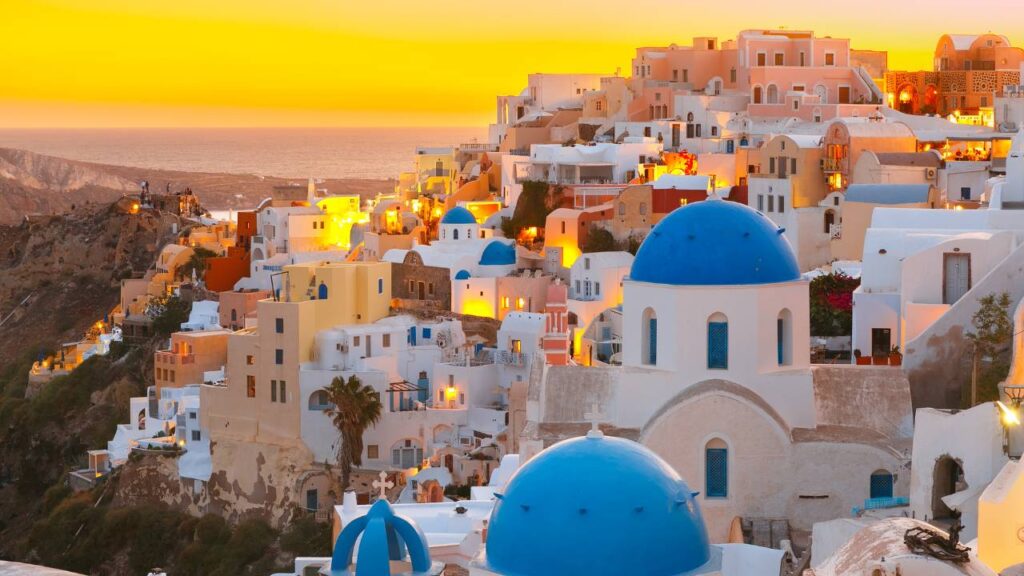
Here’s a detailed guide to the top sunset spots in Santorini, along with some photography tips to help you capture the magic.
1. Oia Castle: Iconic Yet Crowded
Oia is renowned as the most iconic sunset spot on the island, drawing countless visitors every evening. The view from the Oia Castle ruins is unparalleled, with the sun dipping into the Aegean Sea, casting vibrant shades of pink, orange, and purple across the sky. The village itself is perched on the edge of the caldera, offering an unobstructed view of the horizon. Due to its fame, this spot can get quite crowded, especially during the peak tourist season.
To ensure you get a good spot, it’s recommended to arrive 1-2 hours before sunset. The narrow streets of Oia fill up quickly with visitors who are eager to secure the perfect vantage point. While the crowd can detract from the experience, the beauty of the sunset here makes it worth the wait.
Photography Tip: Capture the sunset from Oia’s castle with a wide-angle lens to encompass the entire scene, including the iconic blue-domed churches, the caldera, and the golden hues of the sky. Experiment with silhouette shots for a more dramatic effect as the sun sets behind the buildings.
2. Imerovigli: Panoramic Views Without the Crowds
Who prefer a more peaceful and intimate sunset experience, Imerovigli offers an excellent alternative to Oia. Located a bit further along the caldera, this village is often quieter and less crowded, yet still provides panoramic views that rival those of Oia.
As the sun begins to set, the sky over the Aegean Sea transforms into a palette of warm colors, creating a perfect backdrop for photos. Many boutique hotels in Imerovigli have private terraces or balconies where guests can enjoy unobstructed views of the sunset in privacy, making it an ideal spot for a romantic evening.
Photography Tip: The elevated position of Imerovigli gives you the opportunity to capture the sunset along with the charming whitewashed homes and winding paths that lead up the caldera. Consider using a telephoto lens to zoom in on the light reflecting off the buildings as the sun sets, or try long-exposure shots to capture the tranquil atmosphere of the moment.
3. Fira’s Cliffside Restaurants: Dine with a View
For a combination of great food and stunning sunset views, Fira’s cliffside restaurants are a fantastic option. Perched on the edge of the caldera, many of these restaurants offer unobstructed views of the sunset, allowing you to enjoy a delicious meal while watching the sky transform into vibrant hues.
The added bonus is that you can enjoy traditional Greek cuisine, such as moussaka, souvlaki, and fresh seafood, as the sun dips below the horizon. Fira is busier than Imerovigli or Oia, but it provides a lively and engaging atmosphere for those who want to enjoy the sunset with good food and company.
Photography Tip: Since you’ll be seated at a restaurant, be ready to capture shots through the window or from your seat as the sky changes colors. Focus on creating a balanced composition that includes both the food and the view, using the sunset as a backdrop. For food photography, ensure you use natural light to highlight the vibrant colors of the dish.
4. Lighthouse of Akrotiri: A More Intimate Experience
For a more off-the-beaten-path sunset experience, the Lighthouse of Akrotiri offers an intimate and tranquil setting away from the crowds. Located on the southern tip of Santorini, the lighthouse offers an incredible view of the sun setting over the Aegean, with the caldera and the nearby islands in the background.
The lighthouse itself is a historical landmark, adding an element of charm and solitude to the experience. While it’s not as famous as the other sunset spots, its peaceful ambiance makes it a great choice for those looking to escape the hustle and bustle of the more tourist-heavy locations.
Photography Tip: The lighthouse itself is a striking subject, especially when the sun’s warm colors light up the sky. Capture both the lighthouse and the landscape around it. A wide-angle lens is perfect for this shot, and you may also want to use a polarizing filter to reduce reflections and enhance the colors of the sky and water.
5. Boat Cruise at Sunset: A Unique Perspective from the Water
One of the most magical ways to experience Santorini’s sunset is from the water. Taking a boat cruise during golden hour allows you to witness the sunset from a completely different angle, with the sun setting behind the cliffs and illuminating the entire island in a golden glow. Many catamaran tours offer sunset cruises that include dinner and drinks, making it a truly special experience.
The views from the boat are nothing short of spectacular, with the caldera, volcanic islands, and stunning cliffs surrounding you. Watching the sun slowly sink into the Aegean Sea from the deck of a boat is a serene and unforgettable way to enjoy the sunset.
Photography Tip: When photographing the sunset from a boat, focus on capturing the reflection of the sunset in the water. The moving boat may cause slight ripples, which can add texture and interest to your photos. Use a wide-angle lens to capture the vast expanse of the sea and sky, and experiment with different angles to highlight the dramatic scenery.
Here for 3 days or a full week, this complete travel guide will ensure all the best things to do in Santorini while discovering its hidden corners and timeless charm. Pack your bags—Santorini is waiting.
FAQs
1. What is the best time to visit Santorini?
The best time to visit Santorini is during the shoulder seasons—late spring (April to June) and early fall (September to October). These months offer pleasant weather, fewer crowds, and more affordable prices. If you’re looking for a lively atmosphere with bustling streets and festivals, the summer months (June to August) are ideal but be prepared for high temperatures and higher prices. Winter (November to March) offers a quieter experience but with cooler temperatures.
2. How do I get to Santorini?
Santorini is easily accessible by air and sea. Most visitors arrive by plane at Santorini National Airport (Thira Airport) with direct flights from Athens, Thessaloniki, and major European cities. Ferries and boats are also available from Piraeus Port in Athens, with regular connections during the tourist season. Traveling by ferry offers a scenic route, and there are also high-speed options that take around 4–6 hours.
3. What are the top things to do in Santorini?
Some of the top activities in Santorini include:
- Watching the sunset from Oia or Imerovigli.
- Visiting the Akrotiri Archaeological Site to explore ancient ruins.
- Hiking from Fira to Oia along the caldera’s edge for stunning views.
- Enjoying a boat tour around the caldera and visiting nearby islands like Thirassia.
- Exploring Santorini’s beaches like Red Beach, Kamari, and Perissa.
- Indulging in wine tasting at local wineries like Santo Wines.
4. Is Santorini expensive to visit?
Santorini is often considered one of the more expensive Greek islands, especially in the peak tourist season (June to August). However, there are options for every budget. You can find affordable accommodations in places like Kamari or Perissa, while staying in more luxurious areas such as Oia and Imerovigli will come at a premium. Dining and activities can also vary, with local tavernas offering more affordable meals compared to upscale restaurants.
5. What is the weather like in Santorini?
Santorini enjoys a Mediterranean climate. The summers are hot and dry, with temperatures often reaching 30°C (86°F) or higher, especially in July and August. Winters are mild but cooler, with temperatures averaging around 12°C (54°F). Rain is rare during summer but more frequent in winter. The island benefits from a cool breeze due to its coastal location, making summer heat more bearable.
6. How long should I stay in Santorini?
For a typical visit, 3 to 5 days is ideal to explore the island’s main attractions, relax on the beaches, and enjoy the local culture. If you want to take it slow and immerse yourself in the local atmosphere, 7 days will allow for a more relaxed itinerary with visits to lesser-known villages and extra activities like wine tours and boat trips.
7. What are the best beaches in Santorini?
Santorini’s beaches are unique due to their volcanic origins, offering a mix of black, red, and white sand:
- Red Beach: Famous for its dramatic red cliffs.
- Kamari Beach: A black-sand beach lined with bars, restaurants, and shops.
- Perissa Beach: Another black-sand beach known for its calm waters and lively atmosphere.
- Vlychada Beach: Known for its moon-like landscape and peaceful vibe.
- Monolithos Beach: A family-friendly beach with soft sand and shallow waters.
8. What should I know about Santorini’s local cuisine?
Santorini has a rich culinary tradition, with fresh seafood, locally grown vegetables, and delicious wines being key staples. Some must-try dishes include:
- Fava: A creamy split pea puree, often served with olive oil and lemon.
- Tomatokeftedes: Tomato fritters made with Santorini’s sweet tomatoes.
- Souvlaki: Grilled meat served with pita and salad, a Greek classic.
- Seafood dishes: Due to its location, Santorini is famous for fresh fish and seafood, including grilled octopus and shrimp.
- Santorini Wine: The island is known for its unique white wine, Assyrtiko, which pairs beautifully with local dishes.
9. Can I rent a car or scooter in Santorini?
Yes, renting a car or scooter is one of the best ways to explore Santorini, especially if you want to visit hidden gems off the beaten path. However, keep in mind that roads can be narrow and winding, especially in more rural areas. Scooters are a popular option for those looking to navigate the island more freely, but always drive cautiously, particularly around the busy towns. ATVs are also a common way to get around for more adventurous travelers.
10. Is Santorini family-friendly?
Santorini can be family-friendly but is better suited for families with older children or those who enjoy a bit of adventure. The island’s terrain is hilly, and some areas have steep paths and steps, so be prepared for some physical activity. There are still plenty of kid-friendly activities, such as visiting the beaches, exploring ancient ruins, taking boat tours, and enjoying local ice cream and sweets. However, it’s worth noting that Santorini’s nightlife scene can be more tailored to couples or adults, especially in places like Oia and Fira.

